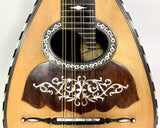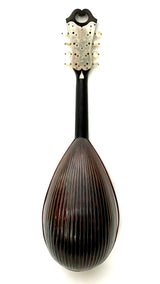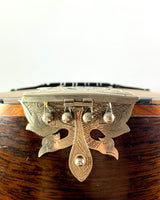Vinaccia
Gennaro & Achille Vinaccia Concert Mandolin from 1900
Sublime concert mandolin made by Gennaro Vinaccia (1832-1908) and Achille Vinaccia (1836-1920), both sons and successors of Pasquale Vinaccia (1806-1885).
The Vinaccia family factory has been able to look back on a glorious past, particularly regarding mandolins. It is also said that it was their workshops that gave birth to the Neapolitan mandolin in the 1750s, thanks to Gennaro (I) and Antonio (I) Vinaccia.
Pasquale Vinaccia, who inherited the family business at the beginning of the 19th century, ran the workshop at 53 Rua Catalana in Naples with his two sons Gennaro and Achille.

Photography by Pasquale Vinaccia
(Source : The Guitar and Mandolin by Philip J. Bone , 1914, between page 220 and 221)
According to Paul Sparks, their father, Pasquale provided a mandolin to the future queen of Italy, Princess Margherita of Piedmont. Thus, later, his mandolin labels will mention the inscription “Instrument maker of the Queen of Italy”.
Pasquale Vinaccia and his two sons Gennaro and Achille are most famous for their mandolins. And it was after Pasquale's death in 1885 that his two sons continued the business jointly under their respective names until around 1899/1900. And it is after this date that a new label will appear, containing only the text "F.lli Vinaccia fu P.le & C..." (Brothers Vinaccia sons of Pasquale & Cie).

Thus, the Vinaccia dynasty played a determining role in the development and evolution of the Neapolitan mandolin, of which here is a very beautiful example dated 1900.
This one, remarkable in its construction, is also remarkable through the humble richness of its fine decorations, its state of conservation and its sound.
Certainly made for a soloist as evidenced by the concert touch, still rare at the turn of the century, the Vinaccia brothers always worked here with a certain taste for visual aesthetics but also for sound.
So their mandolins, as beautiful and well built as they are, also have the reputation of sounding divine.
Not without recognizing the importance of the Vinaccia dynasty and particularly these brothers, Gennaro & Achille, a similar model is in the Musée de la Philarmonie de Paris ( E.995.2.1) after having acquired it in 1995.

(Source: https://collectionsdumusee.philharmoniedeparis.fr/ )
Technical characteristics :
- Top: Spruce
- Base: 33 hollow ribs in rosewood / Ribs in silver fillet
- Sides: Rosewood
- Handle: Beech veneered with rosewood
- Fingerboard: Ebony (concert fingerboard)
- Width at nut: 28 mm
- Radius: Flat
- Frets: 24 frets
- Scale: 330 mm
- Profile: Neapolitan
- Pickguard: Tortoiseshell with white mother-of-pearl arabesque inlay
- Country of manufacture: Italy, Naples
- Year: 1900
- Finish: Natural
- Decorations: Pistagne in white mother-of-pearl and ebony on the edge of the table / Silver and ebony fillets on the edge of the table and rosette / Rosette inlaid with delicate patterns in white mother-of-pearl / Key markers in white mother-of-pearl / Mechanical eyelets in white mother-of-pearl
- Details: Some normal signs of wear given its age
Fully restored and tuned, this mandolin is, in addition to a sublime historical piece, completely playable, a wonderful musical instrument which will delight the most demanding musicians thanks to a sonority of great delicacy combining rich harmonics with excellent definition, the sound carrying naturally, without any harshness.
The malleability of the sound and its depth offer great prospects for evolution, rare for a rosewood instrument.
A typical instrument of the best Vinaccia.
In its period case.
































